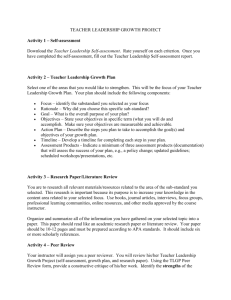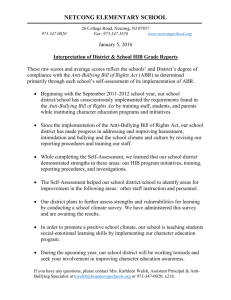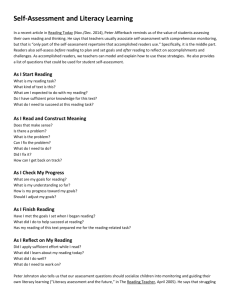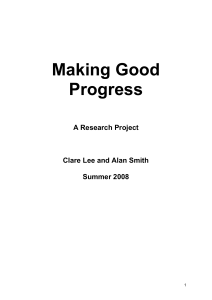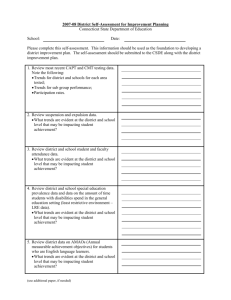Selected References on Self-Assessment in Language Learning
advertisement
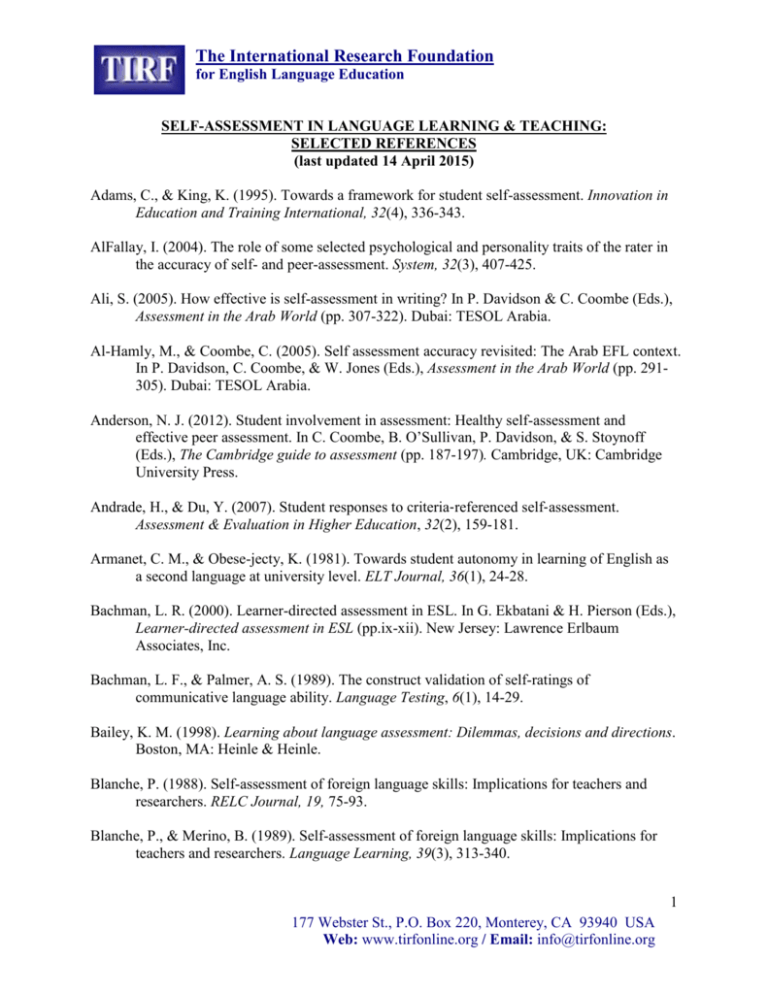
The International Research Foundation for English Language Education SELF-ASSESSMENT IN LANGUAGE LEARNING & TEACHING: SELECTED REFERENCES (last updated 14 April 2015) Adams, C., & King, K. (1995). Towards a framework for student self-assessment. Innovation in Education and Training International, 32(4), 336-343. AlFallay, I. (2004). The role of some selected psychological and personality traits of the rater in the accuracy of self- and peer-assessment. System, 32(3), 407-425. Ali, S. (2005). How effective is self-assessment in writing? In P. Davidson & C. Coombe (Eds.), Assessment in the Arab World (pp. 307-322). Dubai: TESOL Arabia. Al-Hamly, M., & Coombe, C. (2005). Self assessment accuracy revisited: The Arab EFL context. In P. Davidson, C. Coombe, & W. Jones (Eds.), Assessment in the Arab World (pp. 291305). Dubai: TESOL Arabia. Anderson, N. J. (2012). Student involvement in assessment: Healthy self-assessment and effective peer assessment. In C. Coombe, B. O’Sullivan, P. Davidson, & S. Stoynoff (Eds.), The Cambridge guide to assessment (pp. 187-197). Cambridge, UK: Cambridge University Press. Andrade, H., & Du, Y. (2007). Student responses to criteria‐referenced self‐assessment. Assessment & Evaluation in Higher Education, 32(2), 159-181. Armanet, C. M., & Obese-jecty, K. (1981). Towards student autonomy in learning of English as a second language at university level. ELT Journal, 36(1), 24-28. Bachman, L. R. (2000). Learner-directed assessment in ESL. In G. Ekbatani & H. Pierson (Eds.), Learner-directed assessment in ESL (pp.ix-xii). New Jersey: Lawrence Erlbaum Associates, Inc. Bachman, L. F., & Palmer, A. S. (1989). The construct validation of self-ratings of communicative language ability. Language Testing, 6(1), 14-29. Bailey, K. M. (1998). Learning about language assessment: Dilemmas, decisions and directions. Boston, MA: Heinle & Heinle. Blanche, P. (1988). Self-assessment of foreign language skills: Implications for teachers and researchers. RELC Journal, 19, 75-93. Blanche, P., & Merino, B. (1989). Self-assessment of foreign language skills: Implications for teachers and researchers. Language Learning, 39(3), 313-340. 1 177 Webster St., P.O. Box 220, Monterey, CA 93940 USA Web: www.tirfonline.org / Email: info@tirfonline.org The International Research Foundation for English Language Education Blue, G. (1988). Self-assessment: the limits of learner independence. In A. Brookes & P. Grundy (Eds.). Individualization and autonomy in language learning. ELT Documents, 131 (pp. 100-118). London: Modern English Publications and the British Council. Blue, G. (1994). Self-assessment of foreign language skills: Does it work? CLE Working Papers, 3, 18-35. Boud, D. (1995). Enhancing learning through self-assessment. London: Kogan Page. Boud, D. (1995). Implementing student self-assessment (2 ed.). Canberra: Higher Education Research and Development Society of Australasia. Boud, D., & Falchikov, N. (1989). Quantitative studies of student self-assessment and peer assessment. Higher Education, 18(5), 529-49. Bourke, R., & Mentis, M. (2013). Self-assessment as a process for inclusion. International Journal of Inclusive Education, 17(8), 854-867, DOI: 10.1080/13603116.2011.602288. Brew, A. (1999). Towards autonomous assessment: Using self-assessment and peer assessment. In S. Brown & A. Glasner (Eds.). Assessment maters of higher learning education: Choosing and using diverse approaches, (pp. 159-7). Buckingham: The Society for Research into Higher Education/Open University Press. Brophy, T. L., & Good, J. E. (1987). Providing students with opportunities for self-evaluation. In T. L. Brophy & J. E. Good. Looking in classrooms (pp. 504-503). New York, NY: Harper and Row. Brown, A.N., Dewey, D.P. & Cox, T.L. (2014). Assessing the validity of can-do statements in retrospective (then-now) self-assessment. Foreign Language Annals, 47(2), 261-285. Burke, R., & Mentis, M. (2013). Self-assessment as a process for inclusion. International Journal of Inclusive Education, (17)8, 854-867. Butler, Y. G., & Lee, J. (2006). On-task verus off-task self-assessments among Korean elementary school students studying English. Modern Language Journal, 90(4), 506-518. Butler, Y.G., & Lee J. (2010). The effects of self-assessment among young learners of English. Language Testing, 27(1), 854-867. DOI: 10.1177/0265532209346370. Cameron, L. (1990). Adjusting the balance of power: Initial self assessment in study skills for higher education – a case study. In C. Bell (Ed.), Assessment and Evaluation (pp. 63-72). London: Kogan Page. 2 177 Webster St., P.O. Box 220, Monterey, CA 93940 USA Web: www.tirfonline.org / Email: info@tirfonline.org The International Research Foundation for English Language Education Cassidy, S. (2007). Assessing ‘inexperienced’students' ability to self‐assess: Exploring links with learning style and academic personal control. Assessment & Evaluation in Higher Education, 32(3), 313-330. Cram, B. (1995). Self-assessment: From theory to practice. In G. Brindley (Ed.), Language assessment in action (pp. 282-292). Sydney: National Centre for English Language Teaching and Research. Crusan, D. (2011). The promise of directed self-placement for second language writers. TESOL Quarterly, 45(4), 774-780. Dandenault, E. J. (1997). Self assessment of communicative ability: Investigation of a novel tool for ESL learners. Unpublished master’s thesis, Concordia University, Montreal, Canada. Davidson, F., & Henning, G. (1985). A self-rating scale of English difficulty. Language Testing, 2(2), 164-179. Deckert, G. (1989). Cultural background and self-assessment tendencies in an ESL classroom. In V. Bickley (Ed.), Language teaching and learning styles within and across cultures (pp. 128-137). Hong Kong: Institute of Language in Education. De Saint Leger, D. (2009). Self-assessment of speaking skills and participation in a foreign language class. Foreign Language Annals, 42(1), 158-178. Deutsch, R., & Reynolds, Y. (2000). The use of dynamic assessment by educational psychologists in the UK. Educational Psychology, 16(3), 311-313. Flachikov, N., & Boud, D. (1989). Student self-assessment in higher education: A meta-analysis. Review of Educational Research, 59, 395-430. Geeslin, K. (2003). Student self-assessment in the foreign language classroom: The place of authentic assessment in the Spanish language classroom. Hispania, 86, 857-868. Goh, C. (2010). Listening as process: Learning activities for self-appraisal and self-regulation. In N. Harwood (Ed.), English language teaching materials: Theory and practice (pp. 179 206). Cambridge: Cambridge University Press. Hall, J. A., Blanch, D. C., Horgan, T. G., Murphy, N. A., Rosip, J. C., & Mast, M. S. (2009). Motivation and interpersonal sensitivity: Does it matter how hard you try? Motivation and Emotion, 33(3), 291-302. Hanrahan, S., & Isaacs, G. (2001). Assessing self- and peer assessment: The students’ views. Higher Education Research and Development, 20(1), 53-70. 3 177 Webster St., P.O. Box 220, Monterey, CA 93940 USA Web: www.tirfonline.org / Email: info@tirfonline.org The International Research Foundation for English Language Education Harris, M. (1997). Self-assessment of language learning in formal settings. ELT Journal, 51(1), 12-20. Heilenman, L. K. (1990). Self assessment and second language ability: The role of response effects. Language Testing, 7(2), 174-201. Heilenman, L. K. (1991). Self-assessment and placement: A review of the issues. In R. V. Teschner (Ed.), Issues in language program direction: Assessing foreign language proficiency of undergraduates (pp. 93-114). Boston, MA: Heinle and Heinle. Henner-Stanchina, C., & Holec, H. (1985) Evaluation in an autonomous learning scheme. In P. Riley (Ed.), Discourse and learning (pp. 255-263). London: Longman. Hirvela, A., & Pierson, H. (2000). Portfolios: Vehicles for authentic self-assessment. In G. Ekbatani & H. Pierson (Eds.), Learner-directed assessment in ESL (pp. 105-126). Mahwah, NJ: Erlbaum. Hunt, J., Gow, L., & Barnes, P. (1989). Learner self-evaluation and assessment—a tool to autonomy in the language learning classroom. In V. Bickley (Ed.), Language teaching and learning styles within and across cultures (pp. 207-217). Hong Kong: Institute of Language in Education. Jafapur, A. (1991). Can naïve EFL learners estimate their own proficiency? Evaluation and Research in Education, 5, 145-157. Janssen-van Deitan, A. (1989). The development of a test of Dutch as a second language: The validity of self-assessment by inexperienced subjects. Language Testing, 6(1), 30-46. Jones, R., Rusmin, R., & Evans, S. (1994). Self assessment of pronunciation by Chinese tertiary students. In D. Nunan, R. Berry, & V. Berry (Eds.), Language Awareness in Language Education: Proceedings of the International Language in Education Conference (pp. 169-180). Hong Kong: University of Hong Kong. Kirby, N., & Downs, C. (2007). Self-Assessment and the disadvantaged student: Potential for encouraging self-regulated learning?. Assessment & Evaluation in Higher Education, 32(4), 475-94. Klenowski, V. (1995). Student self-evaluation process in student-centred teaching and learning contexts of Australia and England. Assessment in Education, 2(2), 145-163. Lappin-Fortin, K., & Rye, B. J. (2014). The use of pre-/posttest and self-assessment tools in a French pronunciation course. Foreign Language Annals, 47(2), 300-320. 4 177 Webster St., P.O. Box 220, Monterey, CA 93940 USA Web: www.tirfonline.org / Email: info@tirfonline.org The International Research Foundation for English Language Education Leach, L. (2012). Optional self-assessment: Some tensions and dilemmas. Assessment & Evaluation in Higher Education, 37(2), 137-147, DOI: 10.1080/02602938.2010.515013. LeBlanc, R., & Painchaud, G. (1985). Self-assessment as a second language placement instrument. TESOL Quarterly, 19(4), 673-305. Lefkowitz, N., & Hedgcock, J. (2002). Sound barriers: Influences of social prestige, peer pressure and teacher (dis)approval on FL oral performance. Language Testing Research, 6, 223-244. Leow, R. P. (2000). A study of the role of awareness in foreign language behavior: Aware versus unaware learners. Studies in Second Language Acquisition, 22(4), 557-584. Liang, J. (2014). Toward a three-step pedagogy for fostering self-assessment in a second language writing classroom. The CATESOL Journal, 26(1), 100-119. Luoma, S., & Tarnanen, M. (2003). Creating a self-rating instrument for second-language riting: From idea to implementation. Language Testing, 20, 440-465. Mabe, P. A., & West, S. G. (1982). Validity of self-assessment of ability: A review and metaanalysis. Journal of Applied Psychology, 67, 280-296. MacIntyre, P. D., Noels, K. A., & Clément, R. (1997). Biases in self-ratings of second language proficiency: The role of language anxiety. Language Learning, 47(2), 265-287. Malabonga, V., Kenyon, D. M., & Carpenter, H. (2005). Self-assessment, preparation and response time on a computerized oral proficiency test. Language Testing, 22(1), 59-92, DOI: 10.1191/0265532205It297oa. Matsuno, S. (2009). Self-, peer-, and teacher-assessments in Japanese university EFL writing classrooms. Language Testing, 26: 075, DOI: 10.1177/0265532208097337. McDonald, B., & Boud, D. (2003). The impact of self-assessment on achievement: The effects of self-assessment training on performance in external examinations. Assessment in Education, 10(2), 209-220. McNamara, M. J., & Deane, D. (1995). Self-assessment activities towards autonomy and language learning. TESOL Journal, 5(1), 17-21. Mowl, G., & Pain, R. (1995). Using self and peer assessment to improve students’ essay writing: A case study from geography. Innovation in Education and Training International, 32(4), 324-335. 5 177 Webster St., P.O. Box 220, Monterey, CA 93940 USA Web: www.tirfonline.org / Email: info@tirfonline.org The International Research Foundation for English Language Education North, B. (2000). Defining a flexible common measurement scale: Descriptions for self and teacher assessment. In G. Ekbatani & H. Pierson (Eds.), Learner-directed assessment in ESL (pp. 13-47). Mahwah, NJ: Erlbaum. Orsmond, P., Merry, S., & Reiling, K. (1997). A study in self-assessment: Tutor and students’ perceptions of performance criteria. Assessment & Evaluation in Higher Education, 22(4), 357-368. Orsmond, P. Merry, S. & Reiling, K. (2000). The use of student derived making criteria in peer and self-assessment. Assessment and Evaluation in Higher Education, 25(1), 23-38. Oskarsson, M. (1978). Approaches to self-assessment in foreign language learning. Council of Europe: Pergamon Press. Oskarsson, M. (1980). Approaches to self-assessment in foreign language learning. Oxford; New York: published for and on behalf of the Council of Europe by Pergamon Press. Oskarsson, M. (1989). Self-assessment of language proficiency: Rational and applications. Language Testing 6, 1-13. Oskarsson, M. (1997). Self-assessment of foreign and second language proficiency. In Encyclopedia of language and education, Vol 7: Language testing and assessment (pp. 175-187). Dordrecht: Kluwer Academic. Oskarsson, M. (1998). Learner self-assessment of language skills. IATEFL TEA SIG Newsletter, Nov. 1998. Oskarsson, M. (2014). Self-assessment in the classroom. In A.J. Kunnan (Ed.), The companion to language assessment. 1st ed. Hoboken, NJ: John Wiley & Sons, Inc., DOI: 10.1002/9781118411360.wbcla046. Patri, M. (2002). The influence of peer feedback on self- and peer assessment of oral skills. Language Testing, 19(2), 109-131, DOI: 10.1191/0265532202It224oa. Peirce, B. N., Swain, M., & Hart, D. (1989). Self-assessment, French immersion, and locus of control. Language Testing, 6(1), 25-41. Pierce, B. M., Swain, M., & Hart, D. (1993). Self-assessment, French immersion, and locus of control. Applied Linguistics, 14, 25-42. Pope, N. K. L. (2005). The impact of stress in self- and peer assessment. Studies in Higher Education, 30(1), 51-63. 6 177 Webster St., P.O. Box 220, Monterey, CA 93940 USA Web: www.tirfonline.org / Email: info@tirfonline.org The International Research Foundation for English Language Education Porto, M. (2001). Cooperative writing response groups and self-evaluation. ELT Journal, 55(1), 38-46. Powers, D. E., Kim, H-J., & Weng, V. Z. (2008). The redesigned TOEIC (Listening and Reading) test: Relations to test-taker perceptions of proficiency in English. (Research Report RR08-56). Princeton, NJ: Educational Testing Service. Powers, D. E., Roever, C., Huff, K. L., & Trapani, C. S. (2003). Validating LanguEdge Courseware scores against faculty ratings and student self-assessments. (ETS Research Report No. RR-03-11). Princeton, NJ: Educational Testing Service. Rea, P. R., (1981). Formative assessment of student performance: The role of self-appraisal. Indian Journal of Applied Linguistics, 7, 66-68. Rivers, W. P. (2001). Autonomy at all costs: An ethnography of metacognitive self-assessment and self-management among experienced language learners. The Modern Language Journal, 85, 279-290. Roberts, T. (2006). Self, peer and group assessment in E-learning: An introduction. In T. Roberts (Ed.). Self, peer and group assessment in E-learning, (pp. 1-16). Hershey, PA: Information Science. Roberts, T. S. (Ed.). (2006). Self, peer and group assessment in e-learning: An introduction. Hershey, PA: IGI Global. Roman, T. (2013). Using VoiceThread as a tool for self-assessment. In T. Pattison (Ed.), IATEFL 2012: Glasgow Conference Selections (pp. 112-114). Canterbury, UK: IATEFL. Ross, S. (1998). Self assessment in second language testing: A meta-analysis and analysis of experiential factors. Language Testing, 15, 1-20. Shaw, P. A. (1980). Comments on the concept and implementation of self-placement. TESOL Quarterly, 14(2), 261-262. Shrauger, J. S., & Osberg, T. M. (1981). The relative accuracy of self-predications and judgments by others of psychological assessment. Psychological Bulletin, 90, 322-351. Sinharay S., Powers, D. E., Feng Y., Saldivia, L., Giunta, A., Simpson, A. & Weng, V. (2009). Appropriateness of the TOEIC© Bridge test for students in three countries of South America. Language Testing, 26(4), 589-619, DOI: 10.1177/0265532209340195. Smolen, L., Newman, C., Wathen, T., & Lee, D. (1995). Developing student selfassessment strategies. TESOL Journal, 5(1), 22-26. 7 177 Webster St., P.O. Box 220, Monterey, CA 93940 USA Web: www.tirfonline.org / Email: info@tirfonline.org The International Research Foundation for English Language Education Stefani, L. (1994). Peer, self and tutor assessment: Relative reliabilities. Studies in Higher Education, 19(1), 69-75. Strong-Krause, D. (2000). Exploring the effectiveness of self-assessment strategies in ESL placement. In G. Ekbatani & H. Pierson (Eds.), Learner-directed assessment in ESL (pp. 49-73). Mahwah, NJ: Erlbaum. Sullivan, K., & Hall, C. (1997). Introducing students to self-assessment. Assessment and Evaluation in Higher Education, 22, 289-305. Sullivan, K., & Lindgren, E. (2003). Self-assessment in autonomous computer-aided second language writing. ELT Journal, 56(3), 258-266. Tan, K. (2004). Does student self-assessment empower or discipline students? Assessment & Evaluation in Higher Education, 29(6), 651-62. Tan, K. (2007). Conceptions of self-assessment: What is need for long-term learning? In D. Boud & N. Falchikov (Eds.). Rethinking assessment in higher education: Learning for the longer term, (pp. 114-27). London: Routledge. Taras, M. (2001). The use of tutor feedback and student self-assessment in summative assessment tasks: Towards transparency for students and for tutors. Assessment & Evaluation in Higher Education, 26(6), 289-306. Taras, M. (2001). The use of tutor feedback and student self-assessment in summative assessment tasks: Towards transparency for students and for tutors. Assessment and Evaluation in Higher Education, 26(6), 605-614. Taras, M. (2008). Issues of power and equity in two models of self-assessment. Teaching in Higher Education, 13(1), 81-92. Thompson, G., Pilgrim, A., & Oliver, K. (2005). Self-assessment and reflective learning for firstyear geography students: A simple guide or simply misguided?. Journal of Geography in Higher Education, 29(3), 403-20. Towler, L., & Broadfoot, P. (1992). Self-assessment in primary school. Educational Review, 44(2), 137-151. Wangsotorn, A. (1980). Self-assessment in English skills by undergraduate and graduate students in Thai universities. In J. A. S. Read (Ed.), Directions in language testing (pp. 240-260). Singapore: Singapore University Press. Ward, M., Gruppen, L., & Regehr, G. (2002). Research in self-assessment: Current state of the art. Advances in Health Sciences Education, 7, 63-80. 8 177 Webster St., P.O. Box 220, Monterey, CA 93940 USA Web: www.tirfonline.org / Email: info@tirfonline.org The International Research Foundation for English Language Education Weiner, B. (1990). History of motivational research in education. Journal of Educational Psychology, 82(4), 616-622. Williams, E. (1992). Student attitudes towards approaches to learning and assessment. Assessment and Evaluation in Higher Education, 17, 45-58. Wilson, K. M. (1996). Validity of global self-ratings of ESL speaking proficiency based on an FSI/ILR-referenced scale: An empirical assessment. In collaboration with R. Lindsay, Princeton, NJ: Educational Testing Service. Wilson, K. M. (1999). Validity of global self-ratings of ESL speaking proficiency based on an FSI/ILR-referenced scale. (Research Report RR-99-13). Princeton, NJ: Educational Testing Service. Yarborough, C. (1987). The relationship of behavioral self-assessment to the achievement of basic skills. Journal of Research in Music Education, 35(3), 183-189. 9 177 Webster St., P.O. Box 220, Monterey, CA 93940 USA Web: www.tirfonline.org / Email: info@tirfonline.org
